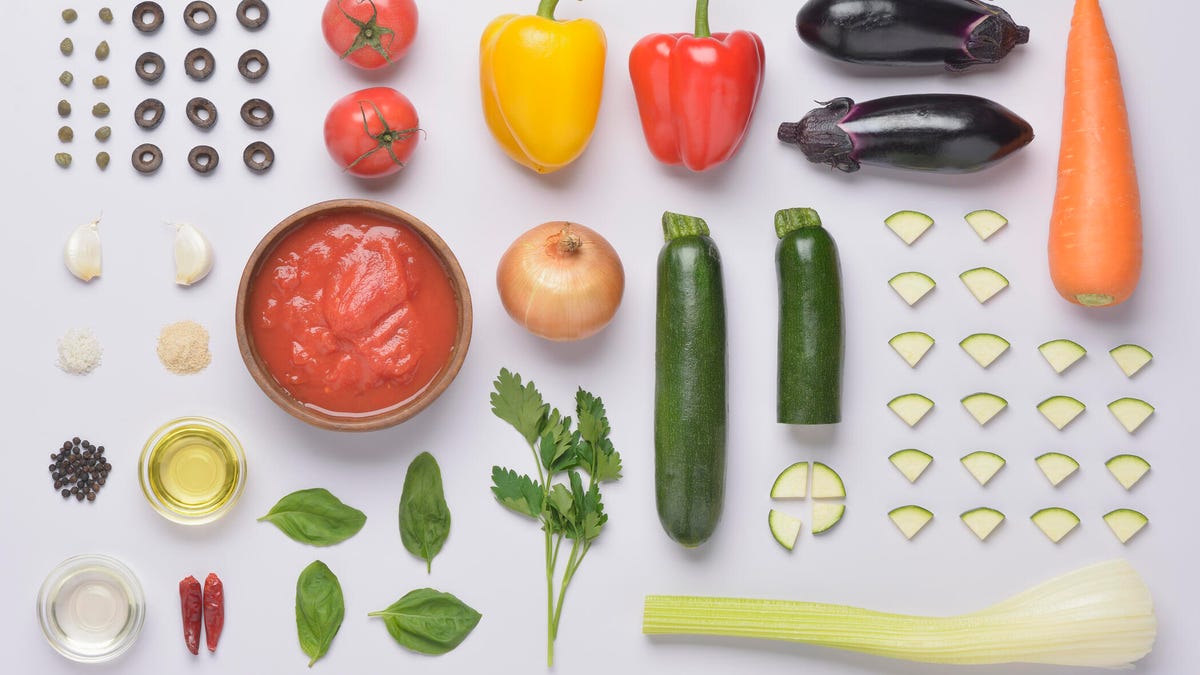How to get your daily servings of vegetables and fruit: A visual guide
We get it, eating enough fruits and veggies every day is tough. This photo guide makes it easier.

Find out what a serving of fruits or vegetables looks like.
Making sense of food serving sizes is tough, especially when many of us rely on packaged foods to tell us how much a serving is (and then ignore it anyway, because snacks are yummy). Anyway, one serving of pretzels is one thing, but how can you tell what a serving of fruit or vegetables looks like?
Is one piece of fruit a serving? What if it's a tiny or abnormally large piece of fruit?
So many questions.
Most people don't eat enough fruits and vegetables each day to best support their health, and some of that might stem from the fact that serving size guidelines are so ambiguous. You may not know how much of each you should eat each day -- or what a serving of fruit or vegetables even looks like. If you're trying to increase your fruit and veggie consumption, use this photo guide to help make sense of servings.
How many servings of fruit and vegetables should you eat every day?
Expert opinions vary, but in general, the answer is "more." Seriously -- the Centers for Disease Control and Prevention reports that nine in 10 Americans don't eat enough fruits and vegetables, so more than you eat now is a good start.
But if you want concrete recommendations, look to the US Dietary Guidelines for Americans. The newest version stipulates that all adults on a 2,000-calorie diet should consume one to two cups of fruit per day and 2.5 cups of vegetables per day. Those numbers shift a little depending on your exact calorie intake.
But that still doesn't tell you how many servings of fruit and vegetables you should eat each day. Waking up each morning and thinking you need to consume 4.5 cups of produce sounds a bit overwhelming.
You may have heard that you should eat five, seven or even 10 servings of fruits and vegetables each day, but those numbers also mean nothing if you don't know what a serving looks like.
What's a person to do?
To make it feel more manageable, I recommend breaking down the US Dietary Guidelines recommendation into half-cup increments. So, you need four half-cup servings of fruit to reach the two-cup recommendation, and five half-cup servings of vegetables to reach the 2.5-cup recommendation.
The American Heart Association supports this method, saying one serving of vegetables can look like a half cup of fresh or frozen vegetables, and that one serving of fruit looks like a half cup of fresh or frozen fruit. (There are some caveats, such as upping the amount to one cup for leafy greens and cooked veggies.)
However, nine total servings of fruits and veggies may feel out of reach. And you may not even need that many, anyway, according to recent research. Eating more than five servings per day does not seem to provide additional health benefits. To be clear, we aren't saying don't aim for nine servings if that feels attainable to you. But don't feel discouraged if that's not in the cards for you yet, because five servings per day can definitely improve your health.
What a daily serving of fruit and vegetables looks like
Using the AHA guidelines on what a serving looks like, plus the long-standing recommendation to eat five total servings each day, here are nine examples of what your daily intake of fruits and vegetables could look like.
Five servings of vegetables: four cups of lettuce, a half cup of mushrooms and a sweet pepper for good measure.
Five servings of produce: one medium banana, one tomato, one orange, a half cup of broccoli and a half cup of carrots.
Five servings of produce: one cup of lettuce, one medium banana, one orange, a half cup of cherry tomatoes and a half cup of blueberries.
Five servings of produce: a half cup of blueberries, half a mango, one bell pepper, one avocado and a half cup of carrots.
Five servings of produce: a half cup of broccoli, a half cup of blueberries, half a mango, a half cup of sweet pepper and a half cup of mushrooms.
Five servings of vegetables: three cups of lettuce, a half cup of broccoli and a half cup of peppers.
Five servings of fruit: a half cup of blueberries, half a mango, one apple and one cup of cantaloupe.
Five servings of fruit: one cup of cantaloupe, one cup of pineapple and one apple.
Five servings of produce: a half cup of mushrooms, a half cup of cherry tomatoes, one cup of pineapple and one avocado.

